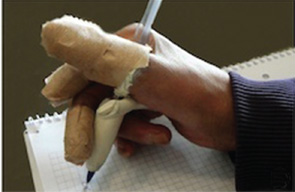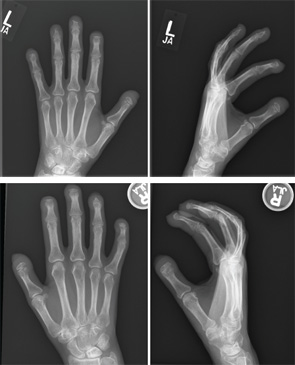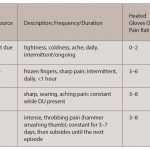
Enlarged grips aid writing. Image Credit: acr image bank
Both occupational therapy and physical therapy play vital roles in rehabilitation, helping prevent contractures, maintain quality of life and assist in returning to prior levels of function.
It’s important to restore the blood flow to the distal upper extremities and increase distal circulation prior to beginning a therapy session.1 Heat packs are commonly used to increase blood flow and improve circulation before exercises are started. However, heat packs must be used with caution if the patient has any loss of sensation due to the risk of skin burns.9
Therapy concentrates on stretching the wrist, fingers, shoulders and hands. Maintaining flexion and extension of the joints is key to keeping the joints mobile and functional. In addition to a home stretching program, it’s useful to provide gentle, manual passive range of motion to all stiff joints.12
Splints have been developed and engineered for patients to help prevent the loss of range of motion and decrease the risk of contractures. Splints can be worn during the day to help with activities or used at night as resting splints.6

Figures 1A, B, C & D: P/A and lateral X-ray views of acroosteolysis in both hands.
Wrist and hand range of motion are important to maintain, but strengthening is also critical. A dynamometer can be used to assess the grip strength of a patient and obtain a comparison between sides. This can be used as a baseline to track progress with strength over the course of a therapy program. Grip strength is a functional measure that people use in their everyday life, so incorporating this into the therapy program is essential. Useful exercises include squeezing rice and putty.
Other joints, such as the shoulders and hips, may be stiff and weak. Thus, it’s useful to include exercises that gently stretch the pectoralis major and minor muscles, as well as the hip abductors.
Effectiveness Demonstrated
How effective are rehabilitation programs? One study compared the effectiveness of twice-weekly connective tissue massage and McMennell joint manipulation for nine weeks, vs. a home exercise program.10 The McMennell manipulations helped restore normal joint movement in all directions and were applied to the wrist, metacarpophalangeal and interphalangeal joints.
Due to the nature of the disease and how it affects the hands, any job requiring pinching or gripping may be particularly difficult. For opening jars or unhooking clips in the workplace, grippers or tourniquets can help patients maintain a better grip on the object. Any job that requires careful manual dexterity will often be more challenging for the patient with scleroderma.



